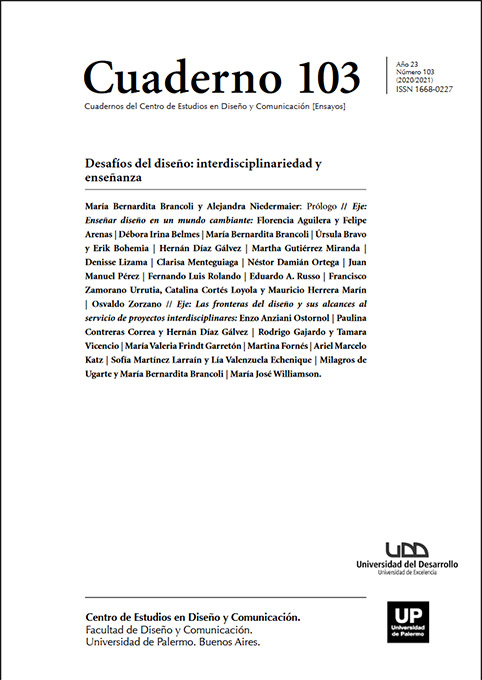Juego, performance y diseño de interacción: un cuestionamiento sobre el límite corporal del diseño
Abstract
For the approach to the crossing of codes from the disciplines of the game and the performance towards the Design of Interaction, it is relevant to position the primary observation from the body7 as a unit to be reconsider for the empathic exercise of designing for people. From the socio-business context, the need arose to tighten the limits of the field of action of interaction design to configure a network of professional actors that implements the possibility of another way to proceed, focused on the community of people rather than the company. This time from the action of the body as a device, together with game methodologies and performance as allies, to enrich the current organizational imaginary. That in turn can enrich the quality of content and how we relate to each other, in a positive way to generate critical mass. The opportunity of the designer to stimulate a community of people (professionals and users), which crosses established codes to stimulate the language of the systemic status quo within which we operate. This essay tries to make comparatively visible the contribution that the confluence of cultural discourses can generate from the disciplines of the Performance (Body) and the Game (Play / Game) to enrich the praxis of the Design of interaction (like analogous experience outside the screen), as a resistance of a social structure stiffened by the interests of the market. The question arises: How can the Interaction Designer contribute to the generation of critical mass? An approach may be the incorporation of tools and concepts from the fields of performance and critical play.
References
Boal, A. (2002). Juegos para actores y no actores. Barcelona: Editorial Alba.
Barnsley, J. (2013). The body as a territory of rebellion, Caracas: Universidad Nacional de las Artes, UNEARTE, 2013.
Castro, F. et al. (2016). Performance art en Chile, Santiago de Chile: Metales Pesados.
Díaz Navarrete, W. (2016). Las Morla. Diarios y Dibujos de Carmen y Ximena Morla Lynch, Santiago de Chile: Ediciones Universidad Católica de Chile.
Flanagan, M. (2013). Critical Play: Radical Game Design, Cambridge: Mass, MIT Press.
Frissen, V. et al. (2015). Playful Identities: the ludification of digital media cultures, Amsterdam: Amsterdam University Press.
Gibbs, A. (2011). Affect Theory and Audience, The Handbook of Media Audiences, Virginia: Nightingale.
Huizinga, J. (2018). Homo Ludens, Madrid: Alianza Editorial.
Jean-Luc, N. (2010). 58 indicios sobre el cuerpo, Extensión del alma, Buenos Aires: Ediciones La Cebra, 2010.
Pàr Pelbart, P. (2015). Cuerpo y Biopolítica. Presentación en “Experimenta sur”, Bogotá: Universidad Nacional de Colombia.
Quesenbery, W. y Brooks, K. (2010). Storytelling for User Experience: Crafting Stories for Better Design. New York, USA: Rosenfeld.
Rolnyk, S. (2015). Pensar desde el saber del cuerpo, Presentación en “Experimenta sur”, Bogotá: Universidad Nacional de Colombia.
Salen, K. y Zimmerman, E. (2004). Rules of play: game design fundamentals. Cambridge: Mass, MIT Press.
Sánchez, J. A. (2015). Presencia y desaparición. Presentación en “Experimenta sur”, Bogotá: Universidad Nacional de Colombia.
Shedroff, N. (2015). Designing Meaningful Experiences, USA.
Zagal, J. y Deterding, S. (2018). Role-Playing Game Studies: Transmedia Foundations, New York: Routledge.
Los autores/as que publiquen en esta revista ceden los derechos de autor y de publicación a "Cuadernos del Centro de Estudios de Diseño y Comunicación", Aceptando el registro de su trabajo bajo una licencia de atribución de Creative Commons, que permite a terceros utilizar lo publicado siempre que de el crédito pertinente a los autores y a esta revista.


